#Chandra telescope
Text

To some it looks like a cat's eye. To others, like a giant cosmic conch shell. This is actually one of the brightest and most highly detailed planetary nebula known- the Cats Eye Nebula. It is composed of gas expelled in the brief yet glorious phase near the end of life of a Sun-like star. This nebula's dying central star may have produced the outer circular concentric shells by shrugging off outer layers in a series of regular convulsions. The formation of the beautiful inner structures, however, is not well understood. The featured image is a composite of a digitally sharpened Hubble Space Telescope image with X-ray light captured by the orbiting Chandra Observatory. The exquisite nebula spans over half a light-year across. Of course, by gazing into this Cat's Eye, humanity may well be seeing the fate of our sun, destined to enter its own planetary nebula phase of evolution ... in about 5 billion years.
Image Credit & Copyright: NASA Hubble, Chandra
Processing Copyright: Rudy Pohl
#astronomy#space#science#universe#nebula#cats eye#cats eye nebula#Hubble#X-ray#Chandra telescope#bright#light year#planetary nebula#sun#explode#supernova#follow#like#reblog#the first star#the first starr#thefirststar#thefirststarr#nasa#apod#tumblr#blog#space blog
170 notes
·
View notes
Text
Hey guys! The future of the Chandra telescope is currently up in the air (no pun intended). The US government is planning on massively reducing the budget for Chandra’s operations, which would cause them to lay off about half their staff. Future planned budget cuts can possibly end its mission altogether. The staff are government workers and cannot lobby for themselves (which is why I’m trying to spread the word 🙂 ).
You can read more about it here
Basically they ask for two things:
1) contact your representatives (if you’re American)
2) sign the in-progress community letter to NASA and Congress (you do not have to be American for this!)
Please sign, contact representatives if you’re American, and share with folks!
Chandra has a decade of mission time left and is continuing to produce amazing data for astrophysics research. Cancelling it a decade early would be a tragedy.
107 notes
·
View notes
Photo

M74 346 !
Combining data from some of NASA’s most powerful instruments, four new composites highlight the enormity of the cosmos in unprecedented detail. Imagery from the Chandra Observatory and the James Webb and Hubble telescopes—plus infrared information from the Spitzer telescope’s final missions—mesh together to generate mesmerizing views of iconic nebulae and galaxies.
Composite X-ray: Chandra: NASA/CXC/SAO, XMM: ESA/XMM-Newton; IR: JWST: NASA/ESA/CSA/STScI, Spitzer: NASA/JPL/CalTech; Optical: Hubble: NASA/ESA/STScI, ESO; Image Processing: L. Frattare, J. Major, N. Wolk, and K. Arcand
#art#photography#space photography#M74 356#Xray#chandra#nasa#space#cosmos#cosmic#universe#james webb#chandra telescope#spitzer#nebulae#galaxy
216 notes
·
View notes
Text
Hey, are you from the US? (If not you can help too) Do you like astronomy, or just care about science in general?
The x-ray space telescope Chandra is about to have its funding cut. Despite working for 30 years, it is still very much operational; it is not more expensive than the other space telescopes; and, above all, there are currently no plans to get it a replacement, like for example Hubble is getting.
You can find the campaign for saving Chandra here, if you are a US citizen you can contact your congress representative, and if not, you can co-sign a letter that is to be sent in support.
#astronomy#chandra telescope#space#science#physics#cawpost#caw caws#i will be happy if this reaches one person haha
9 notes
·
View notes
Text
Science Friday on Euclid and black holes.
#science#science friday#black holes#euclid#james webb space telescope#hubble space telescope#chandra telescope#discovery#space
0 notes
Text
0 notes
Text

Astronomers used three of NASA's Great Observatories to capture this multiwavelength image showing galaxy cluster IDCS J1426.5+3508. It includes X-rays recorded by the Chandra X-ray Observatory in blue, visible light observed by the Hubble Space Telescope in green, and infrared light from the Spitzer Space Telescope in red. This rare galaxy cluster has important implications for understanding how these megastructures formed and evolved early in the universe.
How Astronomers Time Travel
Let’s add another item to your travel bucket list: the early universe! You don’t need the type of time machine you see in sci-fi movies, and you don’t have to worry about getting trapped in the past. You don’t even need to leave the comfort of your home! All you need is a powerful space-based telescope.
But let’s start small and work our way up to the farthest reaches of space. We’ll explain how it all works along the way.

This animation illustrates how fast light travels between Earth and the Moon. The farther light has to travel, the more noticeable its speed limit becomes.
The speed of light is superfast, but it isn’t infinite. It travels at about 186,000 miles (300 million meters) per second. That means that it takes time for the light from any object to reach our eyes. The farther it is, the more time it takes.
You can see nearby things basically in real time because the light travel time isn’t long enough to make a difference. Even if an object is 100 miles (161 kilometers) away, it takes just 0.0005 seconds for light to travel that far. But on astronomical scales, the effects become noticeable.
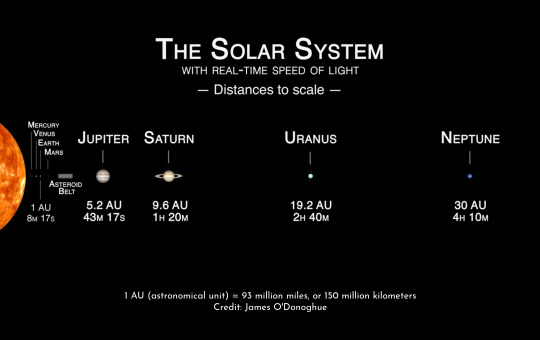
This infographic shows how long it takes light to travel to different planets in our solar system.
Within our solar system, light’s speed limit means it can take a while to communicate back and forth between spacecraft and ground stations on Earth. We see the Moon, Sun, and planets as they were slightly in the past, but it's not usually far enough back to be scientifically interesting.
As we peer farther out into our galaxy, we use light-years to talk about distances. Smaller units like miles or kilometers would be too overwhelming and we’d lose a sense of their meaning. One light-year – the distance light travels in a year – is nearly 6 trillion miles (9.5 trillion kilometers). And that’s just a tiny baby step into the cosmos.
youtube
The Sun’s closest neighboring star, Proxima Centauri, is 4.2 light-years away. That means we see it as it was about four years ago. Betelgeuse, a more distant (and more volatile) stellar neighbor, is around 700 light-years away. Because of light’s lag time, astronomers don’t know for sure whether this supergiant star is still there! It may have already blasted itself apart in a supernova explosion – but it probably has another 10,000 years or more to go.
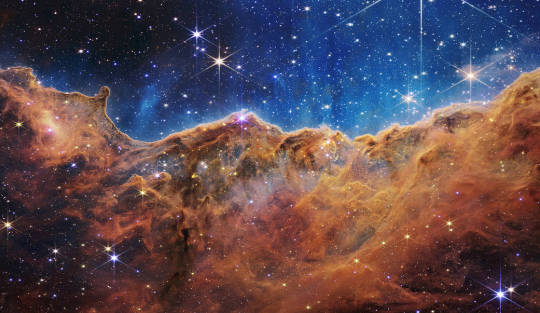
What looks much like craggy mountains on a moonlit evening is actually the edge of a nearby, young, star-forming region NGC 3324 in the Carina Nebula. Captured in infrared light by the Near-Infrared Camera (NIRCam) on NASA’s James Webb Space Telescope, this image reveals previously obscured areas of star birth.
The Carina Nebula clocks in at 7,500 light-years away, which means the light we receive from it today began its journey about 3,000 years before the pyramids of Giza in Egypt were built! Many new stars there have undoubtedly been born by now, but their light may not reach Earth for thousands of years.
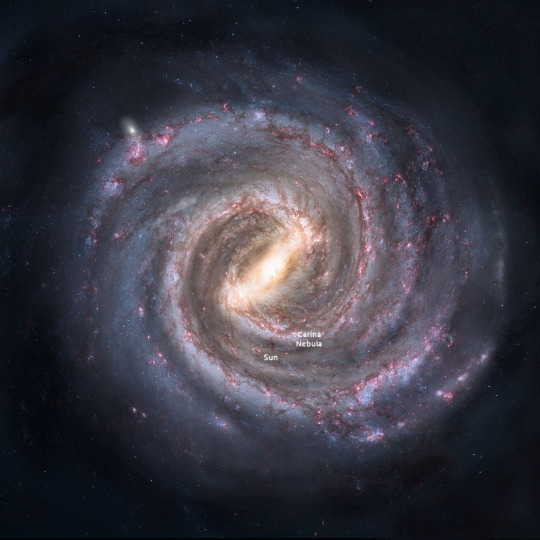
An artist’s concept of our Milky Way galaxy, with rough locations for the Sun and Carina nebula marked.
If we zoom way out, you can see that 7,500 light-years away is still pretty much within our neighborhood. Let’s look further back in time…

This stunning image by the NASA/ESA Hubble Space Telescope features the spiral galaxy NGC 5643. Looking this good isn’t easy; 30 different exposures, for a total of nine hours of observation time, together with Hubble’s high resolution and clarity, were needed to produce an image of such exquisite detail and beauty.
Peering outside our Milky Way galaxy transports us much further into the past. The Andromeda galaxy, our nearest large galactic neighbor, is about 2.5 million light-years away. And that’s still pretty close, as far as the universe goes. The image above shows the spiral galaxy NGC 5643, which is about 60 million light-years away! That means we see it as it was about 60 million years ago.
As telescopes look deeper into the universe, they capture snapshots in time from different cosmic eras. Astronomers can stitch those snapshots together to unravel things like galaxy evolution. The closest ones are more mature; we see them nearly as they truly are in the present day because their light doesn’t have to travel as far to reach us. We can’t rewind those galaxies (or our own), but we can get clues about how they likely developed. Looking at galaxies that are farther and farther away means seeing these star cities in ever earlier stages of development.
youtube
The farthest galaxies we can see are both old and young. They’re billions of years old now, and the light we receive from them is ancient since it took so long to traverse the cosmos. But since their light was emitted when the galaxies were young, it gives us a view of their infancy.

This animation is an artist’s concept of the big bang, with representations of the early universe and its expansion.
Comparing how fast objects at different distances are moving away opened up the biggest mystery in modern astronomy: cosmic acceleration. The universe was already expanding as a result of the big bang, but astronomers expected it to slow down over time. Instead, it’s speeding up!
The universe’s expansion makes it tricky to talk about the distances of the farthest objects. We often use lookback time, which is the amount of time it took for an object’s light to reach us. That’s simpler than using a literal distance, because an object that was 10 billion light-years away when it emitted the light we received from it would actually be more than 16 billion light-years away right now, due to the expansion of space. We can even see objects that are presently over 30 billion light-years from Earth, even though the universe is only about 14 billion years old.

This James Webb Space Telescope image shines with the light from galaxies that are more than 13.4 billion years old, dating back to less than 400 million years after the big bang.
Our James Webb Space Telescope has helped us time travel back more than 13.4 billion years, to when the universe was less than 400 million years old. When our Nancy Grace Roman Space Telescope launches in a few years, astronomers will pair its vast view of space with Webb’s zooming capabilities to study the early universe in better ways than ever before. And don’t worry – these telescopes will make plenty of pit stops along the way at other exciting cosmic destinations across space and time.
Learn more about the exciting science Roman will investigate on X and Facebook.
Make sure to follow us on Tumblr for your regular dose of space!
#NASA#astronomy#telescope#Roman Space Telescope#dark energy#galaxies#cosmology#astrophysics#stars#galaxy#Hubble#Webb#Chandra#Spitzer#space images#Youtube
3K notes
·
View notes
Text
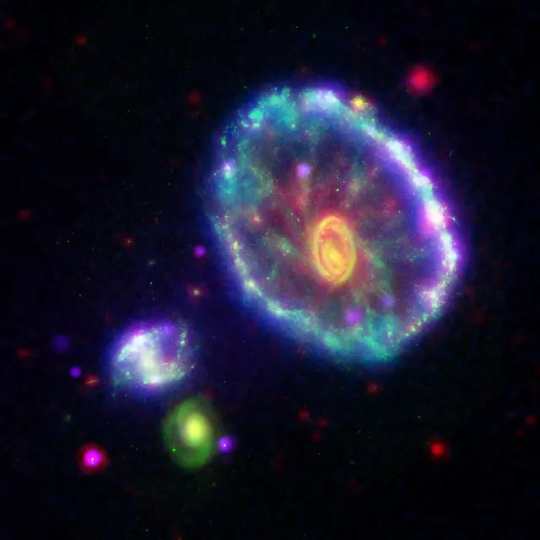
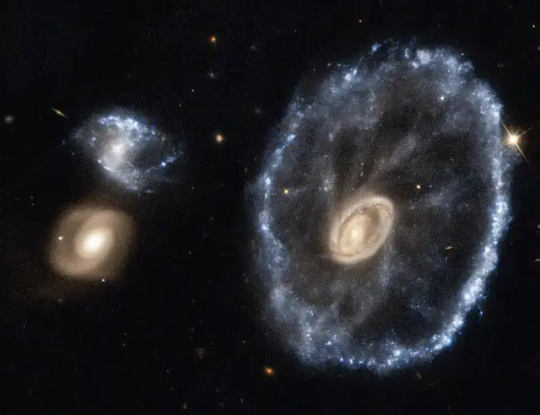

Stellar ripples of Cartwheel galaxy ©
#nasa#chandra observatory#spitzer#space#astrophotography#hubble telescope#stars#cartwheel galaxy#planet#galaxy#solar system#astronomy#cosmos#universe#webb#jwst
2K notes
·
View notes
Text
Scientists have discovered the oldest black hole yet, a cosmic beast formed a mere 470 million years after the Big Bang.
The findings, published Monday, confirm what until now were theories that supermassive black holes existed at the dawn of the universe. NASA's James Webb Space Telescope and Chandra X-Ray Observatory teamed up over the past year to make the observations.
Given the universe is 13.7 billion years old, that puts the age of this black hole at 13.2 billion years.
Even more astounding to scientists, this black hole is a whopper—10 times bigger than the black hole in our own Milky Way.
Continue Reading.
175 notes
·
View notes
Text


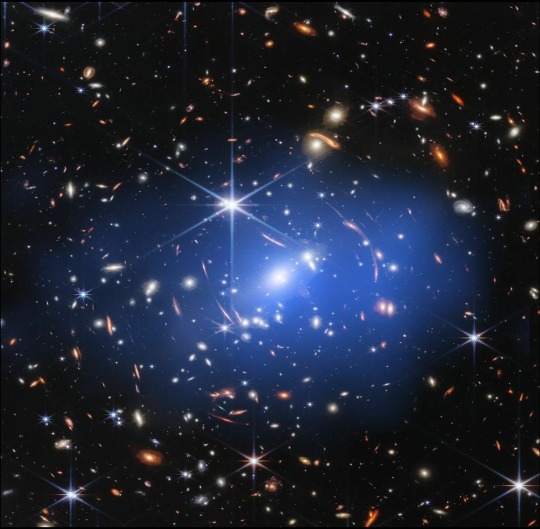
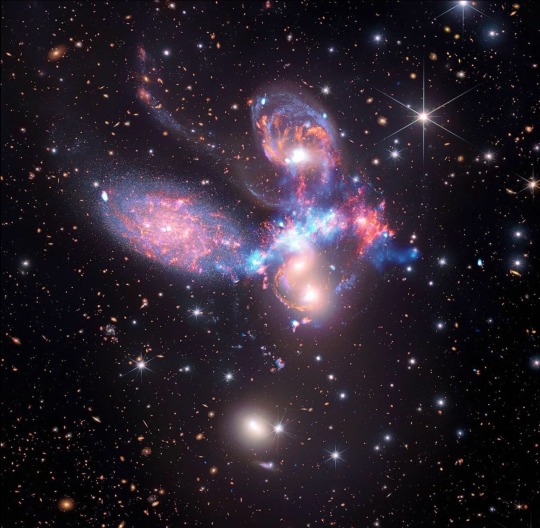
webb's infrared meets chandra's x-ray! technology is amazing <333
#nasa#jwst#james webb photos#james webb space technology#james webb update#james webb images#james webb telescope#chandra x ray observatory#space#outer space#galaxy#stars#sky#astronomy#stephan's quintet#cartwheel galaxy#deep field#carina nebula#aesthetic
960 notes
·
View notes
Text
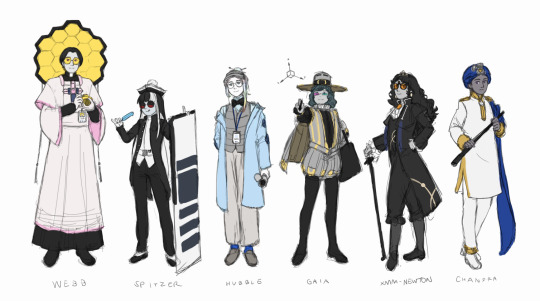
Telescopes 👀😶
#space#character design#gijinka#personification#nasa#esa#space telescope#oh boy time to tag everybody hang tight#jwst#james webb space telescope#spitzer space telescope#hubble#esa gaia#xmm-newton#chandra x ray observatory#religious imagery#priests#christian imagery#thanks webb#artists on tumblr
210 notes
·
View notes
Text

In 2009, NASA overlaid matching images from Hubble, Spitzer, and the Chandra X-ray Observatory to produce this incredible image highlighting each of the telescopes' different wavelength views of the center of our Milky Way galaxy.
"In this spectacular image, observations using infrared light and X-ray light see through the obscuring dust and reveal the intense activity near the galactic core. Note that the center of the galaxy is located within the bright white region to the right of and just below the middle of the image. The entire image width covers about one-half a degree, about the same angular width as the full moon." - NASA
(©)
#go for queue deploy#nasa#nasa hubble telescope#hubble#spitzer#nasa spitzer#nasa chandra#chandra x ray observatory#astronomy#astrophotography#galaxy#nebula#stars#cosmos#cosmic
377 notes
·
View notes
Text

A “Green Monster” Lurks in Star’s Debris
For the first time, astronomers have combined data from NASA’s Chandra X-ray Observatory and James Webb Space Telescope to study the well-known supernova remnant Cassiopeia A (Cas A). This work has helped explain an unusual structure in the debris from the destroyed star called the “Green Monster,” because of its resemblance to the wall in the left field of Fenway Park.
Image Credit: X-ray: NASA/CXC/SAO; Optical: NASA/ESA/STScl; IR: NASA/ESA/CSA/STScl/Milisavljevic et al., NASA/JPL/CalTech; Image Processing: NASA/CXC/SAO/J. Schmidt and K. Arcand
#art#cosmos#cosmic#universe#blast#space#photography#stars#monster#green#debris#chandra x ray observatory#james webb space telescope#supernova#cassiopeia#casA
64 notes
·
View notes
Text



24 December 2023
💚🎄💚
#NASA#Christmas Tree Cluster#Christmas Tree#stars#space#galaxy#universe#cosmos#Christmas#Christmas Eve#Chandra X-ray Observatory#space telescope#space observatory#X-ray astronomy
36 notes
·
View notes
Text
#SaveChandra
I only just learned about this and don't yet know what more we can do other than make this known.
7 notes
·
View notes
Text

Púlsar de la Nebulosa del Cangrejo. Imágenes combinadas procedentes del Telescopio Espacial Hubble (en rojo) y del Observatorio de Rayos X Chandra (en azul).
#astronomy#space#pulsar#neutron star#crab nebula#supernova#crab pulsar#hubble#chandra#hubble space telescope#chandra x-ray observatory#astronomía#espacio#nebulosa del cangrejo#púlsar#telescopio espacial hubble#observatorio de rayos-x chandra#estrella de neutrones
9 notes
·
View notes